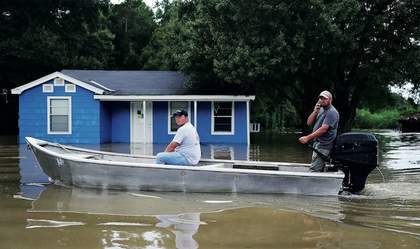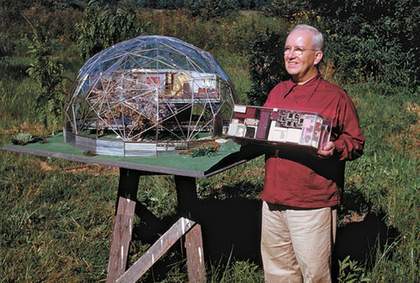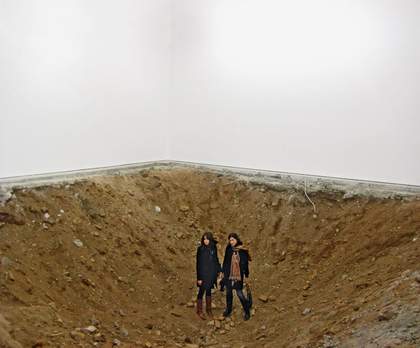
People drive through a flooded road by boat as they visit their neighbourhood in Sorrento, Louisiana on 16 August 2016
© Photo by Joe Raedle/Getty Images
Yes: JM Ledgard
Human systems are failing to manage water, soil, or air for the healthy continuation of life on Earth. Wild creatures are being annihilated. Climate change, the spread of plastics and toxins, the advance of monocultures and vermin suggest a bloody, infested near future. Predictably, politicians are in denial of science, such as on the loss of sea ice. Further to this litany, there is a clearer appreciation that Mars and Titan are barely habitable, while promising exoplanets beyond are going to be more difficult to reach than we could have hoped. In short, we are on our own and we are up against it.
Can artists influence any of this beyond the scream? The answer is yes. The first and most obvious reason why art will have agency is that everything is in play, positive futures are possible, and many artists care passionately, almost painfully, about the living world. The blog roll of those working on climate change issues alone runs to the hundreds. Admittedly, some are vulnerable to missionary positions and green agitprop, but others strike home with melancholic intensity. I think of Rachel Sussman’s photographic series documenting the world’s oldest living things – trees, shrubs, lichen, coral – including a portrait of a 13,000-year-old plant she found at the edge of Pretoria, on which she has crossed out the plant’s age and inked in the word ‘DECEASED’. And it is not just the artists who care. Patrons are also inclined to spend money on ambitious installations dealing with natural destruction.
The second reason is an alliance between art and science at a level not seen since the 18th-century foundation of the Royal Society and French Academy. By backing up the conceptual with the scientific, art has gained in heft. For instance, Olafur Eliasson’s ice sculpture for the 2015 UN Paris Climate Change Conference depended on a collaboration with the geologist Minik Rosing, whose work on Greenlandic ice reset the age of life on Earth. Eliasson had the idea of placing the ice next to humans so they could touch, circle and see themselves as flushed, hot and fleeting against something so clear, cold and ancient, but it was the science that made it profound. The third reason is that artists are more trusted than politicians and are likely to remain so in the confused populist moment. The very unguardedness of art, its intuition, and the fact that it works through wordless light, colour, shade, form and space gives it a separate authority.
The fourth reason for betting on artists is technological. The near future is going to be one of visual fragments, of meta-visions, reconstituted in isolation by individuals on smartphones and mixed reality headsets. This next online life, probably with augmented technology into the human body itself, is going to be a rich area for artists to colonise in ways that are now hard to predict, but will likely contrast the ‘simulacrum’ and the ‘natural’. Perversely, in response to digital connectivity, art shown in public spaces will become more social and coherent, and perhaps more meaningful.
The final reason is that there are not many alternatives to seeing intensely. The scope of the ruination is so grave and fast it is difficult for the polity to conceive of. Economists, philosophers and neuroscientists have all demonstrated that humans have a limited capacity to project themselves into the future. But art can move effortlessly outside of time and space, highlighting the absurdity of naming the year 2017 on a planet that is 4.5 billion years old. Our classical ancestors were locked to land and sky by miasmas, storms, portents, stars, solstices, harvests. Art as various and ambitious as Donald Judd’s geometric sculptures in the Texas desert, Agnes Denes’s wheat fields in New York City, Peter Doig’s lush paintings of the Caribbean, or Tomás Saraceno’s argent airborne sculptures above the Bolivian salt pans can bring us back to that place. That is how art will inform the debate.
JM Ledgard is a novelist, thinker on advanced technology and risk, and a former foreign political and war correspondent for The Economist. His second novel, Submergence, is being adapted for Hollywood by Wim Wenders for release in the autumn.
No: Alastair Smart
In a widely cited 2005 essay, What the Warming World Needs Now is Art, Sweet Art, the environmental activist Bill McKibben lamented how few artists there were tackling climate change. This despite it being, in his view, ‘the single most significant issue’ of our times.
McKibben suggested several reasons for the inactivity. For one thing, climate change is ‘too big’ a subject for artistic treatment – ‘something happening everywhere all at once, it ... becomes backdrop and context instead of event’. He added that – though hugely consequential – gradual shifts in the weather tend to inspire neither artists nor public.
Much has happened in the intervening 12 years. The world now even has grounds for cautious optimism, in the wake of the Paris accord, and as China vows to invest £300 billion in renewable energy by 2020.
Artists, however, have played little part. Insofar as any work sticks in the mind, it tends to be those then-and-now time-lapse photos of retreating glaciers (by James Balog and countless others). There has been nothing close to a climate-change Guernica – in part, because artists of Picasso’s calibre don’t come along every generation. But also because global warming by 0.06 degrees per annum fails to arouse passion quite like the fascist bombing of a small Basque town. Or, to give a contemporary example, quite like atrocities in Syria or the global refugee crisis (a repeated source of inspiration for Ai Weiwei).
What McKibben wrote in 2005 still holds true now. Climate change isn’t evocative enough to get pulses racing. It has no clear narrative or villain. It remains something that, for those of us living relatively comfortable lives in relatively temperate cities, doesn’t have obvious impact – something our grand- children may have to deal with, not us.
These are also highly complex matters: from estimating the nature, extent, pace and location of weather shifts, to what action to take on a political, economic and legal level, locally, nationally and internationally. Without fully understanding these issues, one wonders what artists really have to contribute (beyond eco-agitprop).
Finally, there’s another factor liable to undermine his/her efforts: the charge of hypocrisy. After all, the research for – and making and exhibition of – artworks involves a carbon footprint very much at odds with any environmentalist cause being addressed.
All of which is to say that artists’ influence on this debate has been limited so far – and is most likely to stay that way.
Alastair Smart is a freelance critic and former arts editor at the Daily Telegraph.
The Bonn Climate Change Conference ran from 8 to 18 May; the United Nations Ocean Conference, New York, 5 – 9 June; and the 19th International Conference on Marine Conservation, London, 24 – 25 July.


